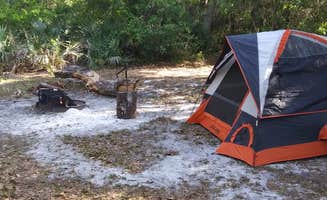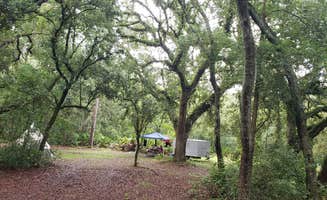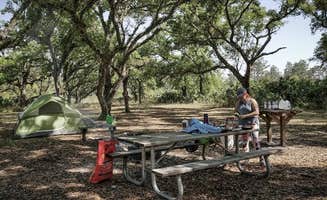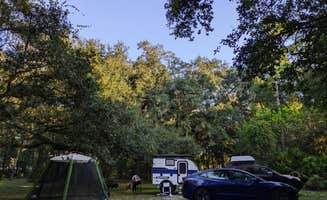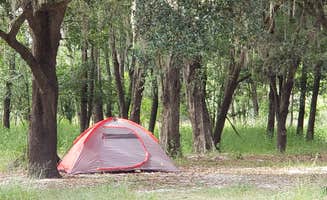Tent campsites near Lakeshore, Florida range from wilderness-oriented sites to primitive backpacking destinations within oak hammocks. The region averages 55 inches of rainfall annually, with camping conditions typically dry from November through April. Summer humidity reaches 90% and brings frequent afternoon thunderstorms, making evening temperatures remain above 70°F even after sunset.
What to do
Overnight tram rides: At Highlands Hammock State Park Campground, special seasonal events offer unique nature experiences. "It was our first trip in our new RV but have been tent camping there before. On this trip we were treated to a night time tram ride because the 26 species of fireflies were out for a 2 week period," notes Larry M.
Spring swimming: Cool off during hot days at natural springs near camping areas. At Lithia Springs Conservation Park, visitors can access the swimming area for a small fee. "Nice spring to swim in for 2.00 a person. Most campsites are very shaded," explains Nate D.
Birding expeditions: Blue Cypress County Park provides excellent bird watching opportunities on the lake. "The lake is a birders paradise if you're into that. All along are big osprey nests in the trees," says B+J S., highlighting the natural habitat that attracts various bird species.
Multi-county hiking: The Upper Hillsborough Preserve offers a unique geographical feature for hikers. "An interesting note is that on a short hike, one can travel through three different counties," making it possible to cross county lines during a single morning hike.
What campers like
Secluded riverside sites: Alderman's Ford Conservation Park Primitive Campground offers true wilderness camping. "The camp sites are hike in only. I LOVE this. Bring a manageable pack with everything you need... Sites were equipped with hammock posts, picnic table, and a fire pit," explains Joe.
Hammock setups: Some campgrounds specifically cater to hammock camping. "Campsite 1, 3 and 4 have hammock poles able to fit 3 hammocks at a time," reports Katelynn L. about Alderman's Ford, making it easier for hammock campers to set up without searching for suitable trees.
Wildlife viewing: The natural surroundings provide opportunities to observe Florida wildlife. "The area is beautiful and shady, staff very friendly, lots of critters on the trails," shares Larry M. about Highlands Hammock State Park. Another camper noted, "We had a bear visit the garbage bin during the night, so you'll have to pay attention to storing your food."
Storm shelters: Hal Scott Preserve County Park offers weather protection for backcountry campers. "The second site, about 2 miles in, has a storm shelter nearby for those sudden afternoon thunderstorms," notes Jamie C., providing safety during Florida's unpredictable weather.
What you should know
Hike-in distances vary: Preparation for the walk to primitive sites is essential. At Hal Scott, "It's a long walk to a primitive site, but totally worth it. If I go again, I'll bring a folding cart to bring more supplies," advises BT E.
Site occupancy uncertainty: Some primitive camping areas operate on first-come systems without reservations. "There's no real way of knowing if the sites are already taken, so be prepared for that," warns a Hal Scott camper.
Seasonal flooding: Water levels affect trail conditions seasonally. "Expect some areas of water covered trails, ankle deep, especially in the summer months," cautions Jamie C. about Upper Hillsborough Preserve — Alston Tract.
Varied bathroom facilities: Campground restroom quality differs significantly. "The best thing about the campsites was that the restrooms back here were way nicer and cleaner than the main park bathhouse which was a mess," notes Elliott B. about Lithia Springs Conservation Park.
Road noise: Traffic sounds can impact the wilderness experience. At Alderman's Ford, "Only downfall is that there is a lot of road noise throughout the entire night. Definitely took away from the 'nature' experience," reports Katelynn L.
Tips for camping with families
Site spacing considerations: Lithia Springs Conservation Park offers room for families to spread out. "The sites are nice and spacious, have really excellent tree coverage (this is a MUST during Florida 'summers')," explains Elliott B.
Weather monitoring: During summer months, park staff often provide weather updates. "The park rangers constantly ensured our safety and were very friendly and helpful. They made sure to keep us up to date regarding changes in weather and flooding," reports Cat A.
Free camping options: Some locations offer no-cost camping with basic amenities. "Can't complain for a free campsite," notes a camper at Hal Scott Preserve, which features "Picnic tables, prep table, & a well pump for water (not for drinking) are welcomed amenities."
Food storage precautions: Wildlife encounters require proper food handling. "We had a bear visit the garbage bin during the night, so you'll have to pay attention to storing your food during the night," warns Sri G. about camping at Highlands Hammock.
Tips from RVers
Weekend availability: Some campgrounds don't require reservations and often have space. "This camp does not allow reservations but had quiet a few empty lots," notes Ryan about Lithia Springs Conservation Park.
Site selection for privacy: At Highlands Hammock State Park Campground, site layout affects privacy. "The campgrounds were nice but all campsites were too close to each other," reports Sri G., suggesting that RVers seek corner sites when possible.
Road conditions: Access roads to some camping areas present challenges. At Upper Hillsborough Preserve, "the drive is very rough due to teenagers mudding out there," warns Nate D., advising caution for RVers with low clearance vehicles.
Extended stay pricing: Weekly rates can be economical for longer visits. "The pricing to stay per week is amazing!" mentions Cat A., highlighting the value for RVers planning extended stays.



